How to Stop Dog Aggression
Vivian Zottola, MSc, CBCC, has all the answers (not to mention helpful dog-training tips) to transform your unhappy pooch into a calm, content dog.
Vivian Zottola, MSc, CBCC, has all the answers (not to mention helpful dog-training tips) to transform your unhappy pooch into a calm, content dog.
by Vivian Zottola, MSc, CBCC, | February 26, 2024
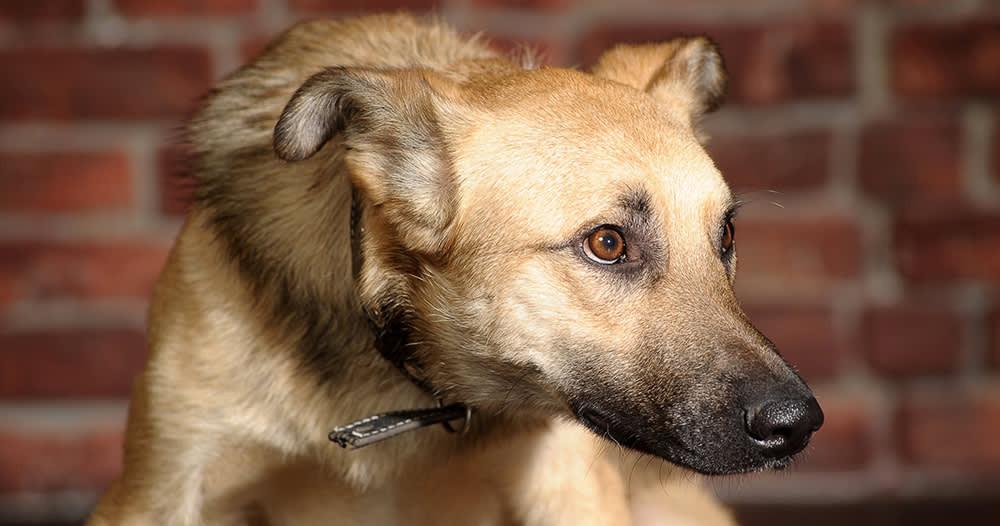
Evdoha / Adobe Stock
As a certified dog behavior consultant, a lot of people come to me in a panic when their dog seems too aggressive. I typically hear concerns such as, “My dog doesn't like other dogs” or “My dog has too much energy” or “My dog won't stop barking.”
Most of these people are new adopters, but some are actually dog pros. Either way, they are justifiably frustrated, confused, even ashamed — because they feel like they’ve tried everything but still can’t understand why their new family member is acting out.
Learning to interpret dog communication, especially low-level stress signals, is the first step to helping your dog. This knowledge helps us proactively and kindly manage these behaviors before they continue to escalate.
According to Dr. Kristina Spaulding, dog aggression is described as being proactive, reactive, and normal. (That’s right, this behavior is normal.) Instead of considering it a bad thing, think of it as a form of communication: Dogs use aggressive behaviors to move something they find uncomfortable or afraid away from them.
Some dogs express aggression intentionally, because they feel that no one has their back or that no one understands their needs. Aggressive displays may be their go-to response, because, over time, they’ve learned that it works.
But it’s also important to understand that stress can build towards aggression. In fact, most dogs usually start by giving subtle signals that they need distance. Some signs include physically moving away, turning their heads away, lip-licking, yawning, cowering, and growling. These stress signals are a few ways they communicate their feelings in the moment. Like us, dogs have a sense of personal space. For some who are a bit more skittish, their “personal bubble” will be bigger. Dogs each have different tolerance levels and escalate their behavior if they aren’t being heard. So it’s normal for dogs that don’t have much control over their lives to display aggressive behaviors (for instance, they may be restricted to a crate for long periods of time or forced to be groomed). Normal aggression is brief, like when you shout out of frustration because you’ve had enough. It can be a protective or self-preservation response. This is a temporary state that often goes away quickly.
Both aggressive and reactive behaviors in dogs are meant to move something away. Aggressive behaviors stem from feelings of fear, frustration, and confusion, while reactive behaviors specifically stem from feelings of anxiety — irrational thoughts or phobias that don’t dissipate quickly. Knowing the difference can change how you resolve the problem.
According to Dr. Karen Overall, a board-certified veterinary behaviorist, reactivity is an irrational response to a perceived threat. Reactive behaviors are triggered by something seemingly harmless: a new person or stranger entering their home, another dog crossing the street, or even an object you’re holding. Your dog may react by running away, crouching, barking, lunging, air-snapping, chewing, or biting to avoid the perceived threat. If your dog responds the same way to new people, dogs, or objects, then it’s likely that their response is based on lack of exposure, past emotional trauma, or a mix of both.
At first glance, we may perceive a pile of growling puppies lunging and biting each other as aggression. But it’s pretty normal. It’s good to encourage puppies to wrestle within limits, practice biting other dogs their age, and hone their play style when they are less than four months of age. It’s also important to intervene every now and again to make sure the pups are okay, and to give them healthy breaks from prolonged play.
At this stage, these youngsters are both teething and learning about social skills with other dogs. Here, behaviors that may seem aggressive actually help dogs learn boundaries, develop critical social skills, and exchange information with each other. This form of play is necessary for young dogs to learn to control their bite level. If one puppy bites another too hard, they are usually ostracized from the group. Young dogs learn to play without hurting others through the consequences of doing the wrong thing.
Proactive aggression in puppies is rare. And when we do see displays of reactive aggression in young dogs, it’s usually due to poor early exposure, trauma, being isolated from the world around them (including from other dogs), and poor training methods. For instance, some people may become upset if their puppy growls when they take something away from them. This conflicted aggression-type behavior — to guard resources — is something we unknowingly reinforce in young dogs. We may give our young dogs something to chew and then suddenly decide to grab the object away, instead of trading the chew with something of equal or better value.
Why do our pets display this behavior in the first place? Shedding light around the action — including the when, where, and who — can give us clues. Here are the top five reasons dogs may get aggressive.
Underlying pain is common and a leading cause of aggressive behaviors in dogs, from teething when they’re puppies to suffering from arthritis when they’re seniors. In a study published by the Center for Canine Behavior Studies, my colleagues and I looked at different types of aggression: conflict aggression towards people or dogs in the household; inter-dog aggression, which is like sibling rivalry; fear-based external aggression towards people or dogs; and predatory aggression and found that a high percentage of the dogs we studied displayed aggressiveness due to underlying physical pain.
If your dog develops sudden aggressive behaviors, consider consulting with your veterinarian to determine if they’re in pain.
Another cause of reactive aggressive behaviors in dogs is limited exposure to new environments. Dogs are always learning, from their time of birth throughout all stages of their lives. Those early days and months, when a dog's rapidly growing brain and nervous system are developing, is a time to ensure they’re protected as they experience the environment they’ll ultimately live in. This includes hearing new sounds, seeing strange new people, encountering other animals, feeling different movements (such as car and bus rides), and feeling new surfaces (tile floors, grass, cement).
It’s best to start exposing your puppy to new environments before they are 12 to 13 weeks old. But this does not mean we should push them to do things that are overwhelming. The key is to expose them in a mild way to unfamiliar circumstances, which will reduce their risk of becoming reactive — because sometimes too much exposure has the same effect as a lack of exposure.
Exposure to the world around them doesn’t just eliminate the element of unpleasant surprise, it also helps young dogs develop a robust nervous system that makes them resilient to stressful events that can cause fear and anxiety. A resilient dog of any age, however, can withstand and recover from uncertain situations, making better decisions because they are not stressed. People can largely achieve this by allowing their pet to have some choice in engagement, whether it means greeting new people or animals, or being groomed. They must feel agency in exploring new things at a level that works for them.
According to Dr. Kathy Murphy, a veterinary surgeon and neuroscientist, various regions of a dogs’ brain develop at different rates. This means, for younger dogs, the decision-making part of the brain (the prefrontal cortex) can’t communicate with the fight-or-flight part of the brain (the amygdala). So it’s normal for them to make bad decisions.
If something traumatic happens to them, they lack the neurobiological stamina to process the incident in a healthy way. (They will also remember it for life.) Adolescence is a very hormonal and difficult time for dogs. We should help them feel safe and protected at this stage, while patiently going back to simply puppy training skills, if necessary. With this guidance, they will usually develop into balanced adults.
The dog-training profession lacks regulations, which makes it difficult to know which outdated and harmful methods to look out for when hiring dog-training help. The American Veterinary Society of Animal Behavior recommends only reward-based training with dogs and other pets. So look out for training that is free of force, fear, intimidation, as well as painful methods and equipment such as prong collars, electric collars, and choke collars.
Multiple studies have proven that correction-management tools lead to stress and anxiety in dogs. In these circumstances, shy, skittish dogs will often display learned helplessness. Meanwhile, more confident dogs tend to develop reactivity, hyper-vigilance, phobias, and even aggressive behaviors in an attempt to remove perceived threats.
Armed with the above information, you can start to figure out how to better support your dog, to make them feel safe and happy. What you learn will also determine if you should reach out for help.
If your dog develops sudden aggressive behaviors, or if you feel unsafe about your dog’s behaviors, contact your veterinarian first. They will evaluate your dog and can guide you, if necessary, to the right professional. The help you require may come in the form of a board-certified veterinary behaviorist, a certified applied animal behaviorist, or a canine behavior consultant.
Dogs bark because they need something from their humans. The way to mitigate barking is to stay ahead of it by making sure your dog’s basic needs are met. There are a number of reasons dog’s bark. They may be hungry, thirsty, bored, lonely, need to relieve themselves, crave socializing with friends, or are alerting you to something unusual going on.
Ruling out separation anxiety, which is the equivalent of a panic attack in humans, is a good first step. Some dogs bark because they feel isolated or haven’t been trained to feel safe alone. If your dog howls for hours, see your veterinarian and consider hiring a certified separation anxiety trainer (CSAT).
If your vet has ruled out separation anxiety, try giving your dog something to do (such as “solving” a food-puzzle toy) or play them bio-acoustic music specifically designed for calm canine behaviors. I recommend the iCalmPet products. You may also look into hiring a dog walker for a smell walk and some sunshine, which helps lift their spirits until you return home.
We unknowingly teach (and reward) pups to jump up on us as a way to say hello. But as dogs grow, people become increasingly annoyed by this behavior.
To shift this behavior, I usually start by carrying some food on me in a treat bag — at all times, so I’m prepared. If a dog jumps on me, I take a step back and turn my head to the side. Stepping back creates imbalance, so the dog safely falls to the ground. And turning my head to the side is a way of telling them, “Move away.” I wait for the dog to have all four paws on the ground or to sit on the ground before saying, “Yes,” followed by reaching in my bag to give them a treat. Dogs will repeat sitting and keeping their feet on the ground when we reward them for doing so.
When I’m outdoors with a dog who loves to jump on people, I typically call their name to look at me. The more they check-in on me, the less they check out. If someone wants to greet my dog, I have one hand firmly holding the dog’s harness and the other hand holding a treat. Then I place the treat on my dogs nose to distract them and anchor their attention. Dogs will also learn they get a bonus treat if they say hello to people with their feet on the ground.
Behavior Problems of the Dog and Cat
Characteristics, treatment, and outcome of 99 cases of aggression between dogs
Clinical Behavioral Medicine For Small Animals
Evaluating Aggressive Behavior in Dogs: a Comparison of 3 Tests
Managing Canine Aggression in the Home
Position Statement on Humane Dog Training
The Stress Factor in Dogs: Unlocking Resiliency and Enhancing Well-Being
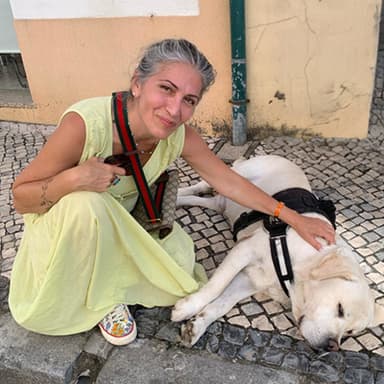
Vivian Zottola, MSc, author of the nonfiction book Being A (Good) Dog In The Human’s World, is a member of the Dog Writers Association of America, and research associate with the Center for Canine Behavior Studies, Inc. She runs a private practice specializing in the prevention and resolution of behavior challenges between humans and pet companion dogs. Find more information at www.VivianZottola.com and Instagram @vivianzottoladogbehavior
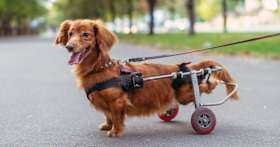
Adoption Advice
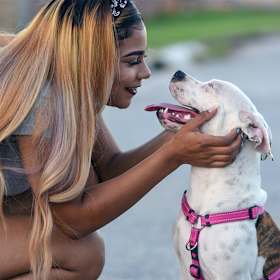
Breed Info
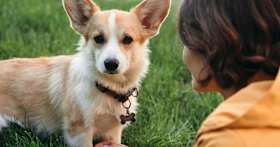
Adoption Advice
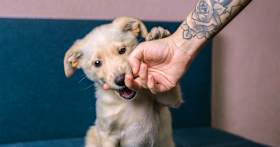
Behavior & Training
Is your new pup biting everything? Learn effective ways to curb this behavior by teaching bite inhibition.
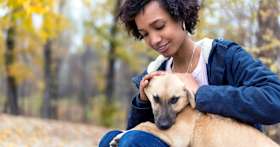
Behavior & Training
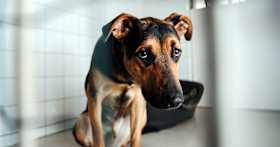
Behavior & Training